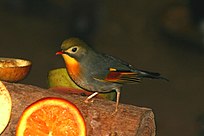Please see Part I of this article for additional information.
Natural History

Pekin robins reach only 6 inches in length, and are attractively clad in olive-green. The throat is yellow, blending with orange at the breast. The black and yellow banded red flight feathers show nicely when the wings are folded.
Space Requirements
Despite their small size, Pekin robins need a great deal of space, and should be housed in an aviary whenever possible. Their feeding mode keeps them on the move all day long, and they will fall into repetitive behaviors if cramped in captivity.
Hailing from mountain-side forests, they are very cold tolerant. If provided with a warm shelter and gradually acclimated, Pekin robins can be housed outdoors year-round throughout much of the USA. This renders them an ideal choice for those seeking an unusual bird that does not require a great deal of indoor space.
Insects and Other Dietary Needs
Pekin robins require a diet rich in insects – they cannot crack or grind seeds. A good insectivorous bird mix should form the base of their diet. Small crickets, mealworms, waxworms and wild-caught insects are all relished. I believe that the provision of a wide variety of insects is key to success with these birds, and urge you to use a ZooMed Bug Napper Insect Trap to catch your own whenever possible. ZooMed Anole Food (dried insects) is also worth trying, and egg food is almost always accepted.
Fruit figures importantly in the diet of wild Pekin robins…berries, oranges, apples, banana, papaya and a host of others should be provided daily. Many individuals will also accept small amounts of carrot, broccoli and other vegetables.
An interesting article describing field research on a population of feral Pekin robins that has become established in Japan is posted at:
http://ss.ffpri.affrc.go.jp/labs/kanko/400-5.pdf
Image referenced from Wikipedia.
 That Bird Blog – Bird Care and History for Pet Birds
That Bird Blog – Bird Care and History for Pet Birds



Looking for pekin robin (male and female in florida , if anyone knows breeder please contact me ..
Hello Donald, Frank Indiviglio here,
I have sent out some emails on behalf of a friend who is also interested in a pair…if I hear anything, I will post a note here on Wednesday,
Best Regards, Frank Indiviglio